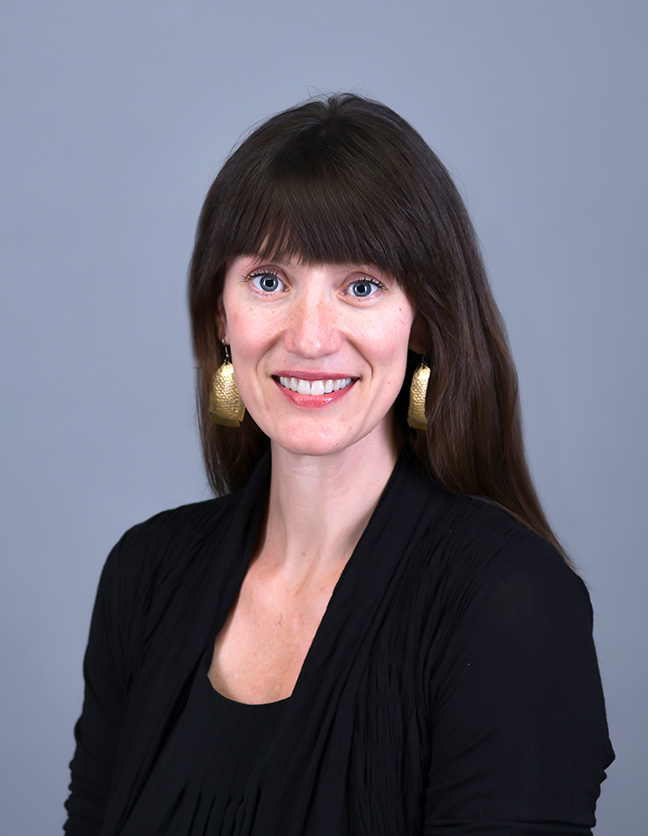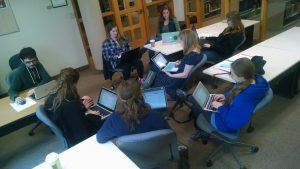By Susanna Childress
 This past January, on an icy Sunday afternoon, I took my husband on a hot date. I know, perhaps not a typical first sentence for the English Department blog. Stay with me.
This past January, on an icy Sunday afternoon, I took my husband on a hot date. I know, perhaps not a typical first sentence for the English Department blog. Stay with me.
Somehow I’d snagged front-row tickets to see Ira Glass—yes, THE Ira Glass—at WMU’s Snow Auditorium. If you’re not familiar, Ira Glass is host and executive producer of the long-running, highly-lauded podcast, “This American Life.” Josh and I also happen to think he’s one of the most precocious, on-point, and winsome public figures we’ll encounter in our lifetime, and we’re pretty picky about our public figures.
Though we’ve been podcast fans of all sorts for years, it’s become a ritual to listen to “This American Life” while we do the evening dishes, clean up the day’s mess, set out the next day’s lunch. We find the episodes entertaining, certainly, but they also provide us with a type of news we’re hungry for—truly, sometimes even infuriatingly, complex—good journalism, funky journalism, raw and real, stories and people and scenarios that make us question, and curse, and laugh, and cry. We regularly do all four of those things as we bend over the dishwasher or spread a bagel with peanut butter and jelly because these well-crafted episodes include such a gamut of the human experience, from the retelling of a hilariously chaotic Peter Pan production to an up-close exploration of the devastating state of segregation within our public school system. “This American Life” is not messing around.
I’d already decided I wanted to do a class podcast with 358, Intermediate Creative Nonfiction, in the spring semester, since literary essay-writing and this kind of journalism—sometimes called immersive or literary journalism—have much in common. I knew that we’d model our episode after “This American Life,” and I’d been brainstorming with Josh which episodes were the best to assign and enjoy/analyze/steal from as a class. But for whatever reason, when I bought the tickets last fall to see Ira Glass, I thought I was going on a really great date that kind of sort of happened to tie into this thing I was going to try in one of my classes. Front row tickets, man. With my man, man. My kids’ favorite sitter lined up and a trip out of town, man. HOT, right? (No joke, I’m living large here, folks.)
But then we arrive and take our seats and the lights go down and from the minute Ira Glass steps on that stage, it’s as if he knew there was a gal on the front row teaching a creative nonfiction class and planning to incorporate a podcast assignment. It was as if he had designed his talk to teach me how to teach this assignment. His whole talk—riveting from the first word to the last, not only because the guy is wryly comedic but also intelligent, kind, self-aware, and convicted—encompassed why they saw a need for “This American Life” in broadcast journalism, what they hope each episode is doing to fulfill that need, what they look for, where the material comes from, how they craft an episode, how that process has evolved, and why the narratives in “This American Life” are so important—even necessary—in our lives. He talks semiotics and storytelling. He speaks at length about his own undergraduate education. He shares highs and lows of his time in broadcast journalism as well as thoughts on the recent boom in and popularity of podcasts.
By and large, Ira Glass gives an enormous craft talk. He teaches me how to teach what a podcast of this sort is, what to aim for, and how to hit it.
Of course I’d come without paper and pen (who brings that stuff on a date?) so there I was, on the front row, madly tapping out notes on my phone, which galled the women next to me into several sidelong glares and a couple tornadic sighs. Did she think I was texting? I wanted to lean over and say, “This is bugging me, too. You have no idea. I need a whole notebook and my best ballpoint right now, not two ridiculous thumbs!” but I was too busy typing out what I could summarize, key points and main ideas, juicy bits and stunning bits, to commiserate. His talk went nearly two hours, what with excerpts from several episodes and a Q&A with the packed auditorium. Josh and I both said we could have—would have gladly, with bonus overtime for the sitter—listened to him for several more hours.
We didn’t want to leave. (Now that’s a hot date. Am I right?)
The next “podcast” class session with my creative nonfiction folks, I was bursting. I stammered over myself in excitement. I mean, I’d sat at the feet (yes, literally) of the Master Podcaster Himself!
And my dear, beguiled students—all eight of them—were game.
They took it in stride (…that their professor was coo-coo for Cocoa Puffs, so to speak). They invested themselves. They made it their own. On their own. (I cut the kite strings early so it could truly be something of their own making.) They rose to the occasion. They took risks. None of them had done this kind of podcast, which requires a very specific sort of writing that’s a hybrid of the journalistic and literary. Where they collaborated and had to rely and build on the work of their classmates. Where their voices were on display in a digital format. For all to hear.

These 358 students worked together to create a 35-minute podcast with several “acts” (segments that fit together and build around a theme). They each had something to contribute. And, as far as I can tell, they walked away with a greater understanding of (and deep appreciation for) the exact kind of creativity, endurance, patience, thoughtfulness, teamwork, and tech-savvy it takes to pull off every single episode of a podcast like “This American Life.”
We all learned a lot this semester, not least of which is how easily a hot date can turn into a “craft” moment you didn’t even know you needed…which sometimes can turn into teaching-and- learning moments you did nothing—minus the happen-chance to be in the right place at the right time—to deserve. (Maybe we should all go on more dates?)
Please enjoy the following 10-minute excerpt of the podcast, whose theme is “Growth,” from the spring semester’s 358 class. This act begins with a portion of an interview with Hope biology professor Dr. Greg Murray by Elizabeth Ensink and then proceeds to writing and interview by Madison Veverka (with her grandmother) with folded interview questions by Josue Guitron; final editing and production was done by Katie McMorris and Elizabeth Ensink.

